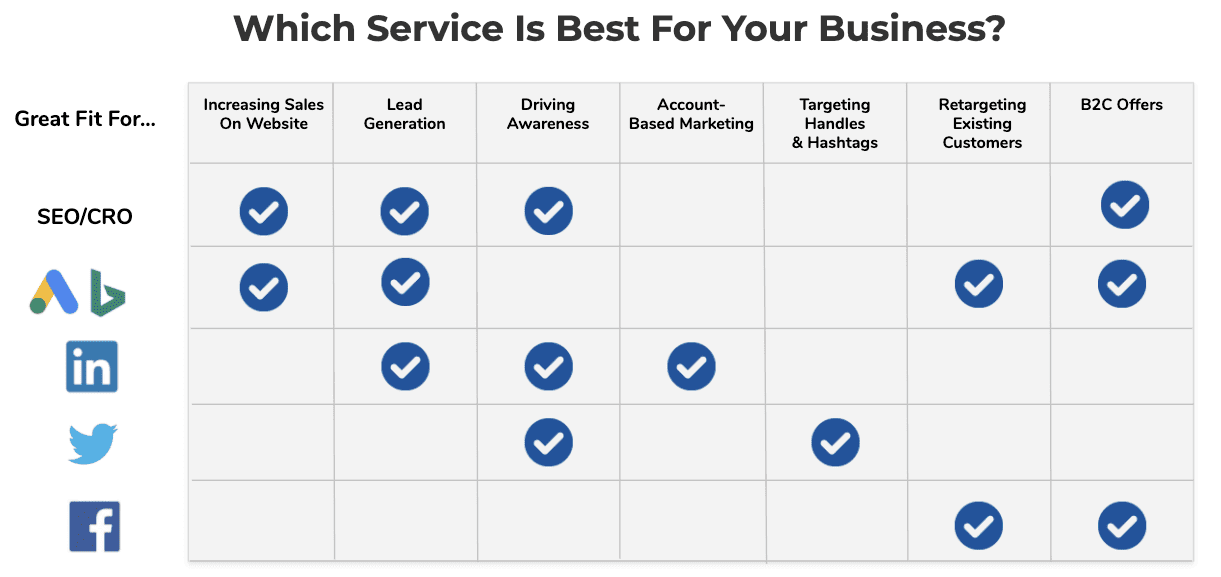Conversion Optimization, Digital Strategy, SEO & Content Marketing, Web Development, Website Design & UX
15 Minutes
The Most Controversial Topics in Life Science Digital Marketing Today
Finding and partnering with a digital marketing consultant or agency is vital for expediting the growth of most companies. One of the challenges, no matter what industry you’re in, is that you’ll have to rely on the expertise of external consultants.
In the world of digital marketing, there isn’t a real licensing or certification similar to what a doctor, lawyer or accountant can obtain to determine whether or not they’re the most qualified candidate or not.
This means that you’ll need to rely heavily on doing your homework to select the right consultant who provides the best possible recommendations.
Generally speaking, in my industry, the life sciences, I find that digital marketing consultants fall within three key categories:
- Inexperienced or under-qualified to give the best advice.
- Snake-oil salesman (to be fair, these exist in any industry).
- Highly qualified and experienced but at a high price point.
Few things are worse than committing to a large, expensive project and realizing months or years later that it wasn’t the right decision. In the last eight years, I’ve encountered numerous horror stories from clients who have described previous experiences.
The economic impact of making the wrong decision in digital marketing can be significant. Building your website on the wrong platform with the wrong marketing team can be extremely risky.
Launching social and paid campaigns on the wrong networks or without proper oversight can drain your budget on strategies that definitely have zero ROI.
In this post, I plan to share with you my top advice on a few of the most controversial topics in digital marketing.
1. SEO is not dead. It’s like planting a seed.
In the SEO community, there are two groups of beliefs.
- SEO is dead and it doesn’t work. I hear this the most from agencies that don’t have much experience in SEO and would rather help you with something they believe has more value.
- SEO is like magic and we can get your keywords to rank at the top of Google by engaging in a bunch of tactics. I hear this perspective from agencies that have a very formulaic approach to SEO that generally includes a degree of fluff combined with a few things that do work.
If you’ve been in the SEO game as long as I have, you’ll know that SEO is both alive and well, but the strategies have transformed over time. It’s become way more difficult to do well, which is why many in the community believe it to be either dead or are still trying to sell a magic pill approach.
More than five years ago, SEO was an arms race to do whatever possible to game Google’s algorithm. This meant building shady backlinks, loading your website with outrageous amounts of keyword stuffing and more.
Times have changed and SEO has become more holistic, tied to overall web experience. Ultimately, SEO is simple - there are certain websites that rank well on Google search and others that don’t. There are definitely things that impact your rankings because we know there are algorithms to determine relevance.
The challenge is that the algorithms became more complex and, therefore, it’s important to understand what today’s top ranking factors actually are for SEO.
SEMrush, the leader in SEO competitive research, analyzed a database of 600,000+ keywords and determined top ranking factors for SEO.
Here’s what actually matters.

Long story short, today, SEO is like planting a seed. You need to constantly give it attention, give it sunlight and water in the right conditions, and it takes time to grow. SEO strategy is impacted heavily by overall web engagement, user experience, and much more. A simple SEO plugin isn’t going to make your SEO amazing nor is an agency that plans to offer you 10 backlinks a month from some fake websites that they built. You need well thought-out content strategies, and commitments from your team to be persistent.
At Supreme, each keyword is selected by a Ph.D.-level SEO strategist who understands what you’re actually selling, content is written by a Ph.D.-level copywriter that actually takes the time to understand your business, customer’s journey, value proposition, differentiators and more. You won’t see results in a matter of weeks.
Think timeframes of 3-6 months as a minimum, and on-going as long as you want to stay competitive with the best out there. If you are patient and strategize well, you can see some incredible, long-term and sustainable results.
2. Your Website Is Not a Commodity. It Should Be Your #1 Salesperson.
It’s true that today you can build a website over a weekend on platforms like Squarespace. For some individuals, or small businesses this might be sufficient.
However, if you are planning to differentiate your business, scale your lead generation, get the interest of your potential investors, patients, healthcare professionals and other partners then you need to build something that serves that purpose.
Your website is supposed to be your #1 salesperson and #1 marketer. Think of your top salesperson and the attributes they should have. You want someone who has been successful in the past, understands your market and customers, and has both hard and soft-skills to nurture and close deals.
Most don’t think their top salesperson is a commodity that can be found anywhere, so why do people assume just anyone is qualified to build their website?
Based on our findings, we know that within life sciences, roughly 70% of the customer’s buying/decision making journey is already complete by the time they decide to reach out and contact you. That means you need to be able to anticipate the customer journey ahead of time. Take a look at the five steps below as part of a customer’s journey. Do you know the answers to your customer’s questions?

Your website is the most important touchpoint for your potential customers. It represents the face of your business. It gets in front of potentially hundreds or thousands of people per day. It needs to communicate the key points about what you do, how you’re different and why someone should work with you.
Thought experiment.
At even a small-medium sized business, the annual salary of your #1 salesperson can easily be 6-figures per year. Why are companies so hesitant to invest the same into a website? A high-performing website can result in multiple times the ROI of a single sales person.
Furthermore, for many life science companies, even one extra deal closed can justify the ROI for the entire cost of a website and more.


3. If The Person Managing Your Google Ads Doesn’t Have a Deep Understanding Of Your Company’s Products and Applications, Stop Wasting Your Budget Now.

Here's an example of a company that has spent $2,561.17 targeting for irrelevant keyphrases like Santa Cruz, Santa Cruz Bikes and Santa Cruz Skateboards when they intended to bid on Santa Cruz Antibodies.
If your Google Ads (and other forms of paid advertising) are managed by someone who doesn’t have a deep understanding of your company’s products, applications, and target audience, I would just pause the campaign now.
The bottom line is that it does not matter how skilled someone is at Google Ads or other networks. If they don’t truly speak your customer’s language, and understand exactly how your products solve your customer’s problems, there is no way they’re going to be targeting the right keywords or writing the correct ad copies that resonate with audiences.
I know this from first hand experience. When we first started running Google Ads for clients, I had an expert with 10 years of experience in Google Ads managing the account. The problem was that no matter how good their understanding of the network was, they couldn’t grasp the concepts of what the ads were able to do, the specific pain points of the target audience and the most compelling benefits.
There’s a reason we have 12 Ph.D. level scientific marketing specialists in-house on our team. Keywords, ad copy, campaign setups, audience targeting and more are all done by people who actually know what you do. It seems like something basic but trust me, it’s constantly overlooked.
If you’re curious how your campaigns are going, just reply to this email and we’ll have one of our Ph.D. Scientific Marketing Strategists do a free audit for you.
4. Digital Marketing Will Not Make Up for a Bad Product or Offering
Sometimes you don’t have a marketing problem. Sometimes you have a problem with your offering. That’s something that can be solved, but not through digital marketing.
Sure, there are exceptions to the rule, and we’ve seen plenty of bad products heavily marketed and have some degree of success. In the long term, this isn’t a sustainable option. Today there is more transparency than ever with reviews online, comments on social posts, and more that you can’t just brush under the rug.
The bottom line is that you need to be honest about what the root issues are. Digital marketing can help you reach conclusions by providing additional data points but it isn’t going to be a magic pill to drive revenues if your offering is underdeveloped or doesn’t address the need of the customer.
This point is especially important for a company that is in the early stages and just starting to figure out the basics such as price point, the problem your product is solving for the audience and more.
The solution here is to spend extra time improving your products, testing them, getting customer feedback and then investing again in the marketing efforts. You need to believe in your products, understand how they're different and unique, and what your advantage is against competitors.
5. What Type Of Life Science Companies Benefit from Specific Digital Marketing Services & Channels?
Should you invest in SEO, LinkedIn, Google Ads, Facebook, or Twitter?
In general, here are my team’s observations on what works and doesn’t work in the life science industry over the last eight years.
SEO and Google Ads/Bing Ads are excellent fits for companies that have customers actively searching for the problem they solve (or the solution they offer). In other words, if customers aren’t aware that your solution exists yet, they probably aren’t searching for it.
LinkedIn is your network of choice for targeting specific accounts and sharing innovative new technologies. If your prospect doesn’t know about you today, but you know who might be interested, LinkedIn is your best bet.
Twitter Ads can be powerful for specific content-marketing and thought-leadership but usually only if you’ve already produced those assets. In addition, it can be useful for promotion and advertising during conferences with hash-tag targeting.
Facebook Ads can be a good fit for retargeting existing customers or if you have direct to consumer products.
Finally, organic social media on Facebook, Twitter, LinkedIn and other channels right now probably isn’t the greatest use of time or budgets for most small-medium sized businesses in life sciences. There are few life science companies that do organic social well, and these are very time-intensive and strategic campaigns.
If you want an example of who I think is doing organic Instagram well, look no further than Sigma-Aldrich’s Instagram. For all the nerds like me who love organic chemistry, I think they’re doing an amazing job, but even so, it might be hard to measure direct ROI.



6. The Most Common Corners Cut by Web Development Agencies
The range of how much a website costs can vary tremendously. It can go for as low as a few hundred dollars to a few hundred thousand dollars. Here are just three examples of what immediately comes to mind separating premium shops with cheaper ones. Although cost undoubtedly does increase to do things the right way, there also lies a substantial risk of skipping these steps and sacrificing the overall performance of your website.
1. Mobile design
Most modern websites today are responsive but there’s a difference between a mobile specific design and just letting the website respond by itself. You’ll see that all three of these websites have varying levels of mobile-responsiveness.
DWK Life Sciences, a site that we launched recently, has full mobile responsiveness, which included a mobile specific design.
Thermo Fisher does respond, but you can see they have problems with the actual degree of responsiveness. Graphics, buttons and text are misaligned and not styled consistently.
Sigma-Aldrich isn’t mobile responsive.
In addition, you’ll see when it comes to navigation on mobile, there is out of the box mobile navigation versus custom designed, and mobile responsive as you’ll see with our FUJIFILM example below.


2. Strategy and Discovery
Numerous web agencies don’t dive deep enough into the actual strategy of the website through a detailed and comprehensive discovery phase. I’d also argue that most agencies simply don’t have the core expertise to do so, therefore they naturally gravitate towards what they’re comfortable doing.
Most of the time, web agencies are the most comfortable with either doing the development work of assembling the pieces, while some are comfortable doing the designs.
The problem is that the most important aspect for a successful project is also the most commonly overlooked.
A discovery process involves devoting enough time to understanding the market, the audience, how you’re positioned in it, and what the greatest areas of opportunity are. They involve comprehensive qualitative and quantitative research in the form of customer interviews, stakeholder surveys, customer journey research, data analysis from web, offline channels like the CRM, SEO research and competitive research.
Strategy and discovery done well is extremely high-touch and requires high-level expertise who are qualified with industry-specific and domain-specific experience. Then, to make it more complicated, these functional and technical requirements need to be translated into actionable and prioritized deliverables that also require a deep understanding of the tech stack and any limitations there.
I won’t lie to you. It’s a lot of work. And it isn’t always so profitable to employ highly specialized experts for an agency. That’s why most agencies won’t delve so deeply into this realm. After all, it’s easier, less stressful and probably high-margin to buy a $49 WordPress template from ThemeForest.net and plug the customer’s content into the canned options available than building, strategizing and designing from scratch, starting with what the customer actually needs.
3. Search Engine Optimization
This point really ties further into the first point about SEO that I made earlier in the article. The bottom line is that there’s a substantial difference in someone who says they make your website SEO friendly without getting into details compared to a Ph.D. level SEO specialist going through a proven process.
The right way to do SEO involves taking the time to uncover every possible relevant keyphrase that has search volume, understanding what pages are currently ranking for what keywords on your existing website, assessing competitors and your opportunities all for the purpose of helping you decide on your new information architecture, structure of your pages, and what each page should contain when it comes to content.
There’s a totally incomparable difference here and the results speak for themselves when a site has an integrated SEO strategy built into the web development and design process.
7. Watch Out for Vanity Metrics
There are so many metrics out there, how do you know what you should really be looking for to measure success?
The truth is that there are a lot of important key performance metrics (KPIs), but also a lot of vanity metrics that may or may not really have any impact on moving the revenue needle. The problem is that so often agencies will show “amazing results” such as traffic, impressions and more, but we never get to see the actual estimated financial impacts. Traffic, impressions and other metrics can easily be misleading without knowing the entire picture.
You have to be able to understand the context of those KPIs in order to make the best decisions based on the data. Case-by-case assessments are common when examining web KPIs.
- eCommerce Web Revenue
- Pro: This is real web revenue from eCommerce. It’s literally cash.
- Con: No big cons here, this is probably the best you can get. Just make sure the data is validated.
- Pro tip: If you’re doing 10% or greater of total revenue from your eCommerce store, you’re doing well. If you’re doing less, then it’s time to consider a major update to your website.
- eCommerce Conversion Rate
- Pro: Double your conversion rate from eCommerce transactions, double your revenue. This is one of the most impactful things you can do.
- Con: No big cons here.
- Pro tip: The average baseline for life science eCommerce companies is a 1% conversion rate.
- eCommerce Average Order Value
- Pro: The more someone spends per transaction the better. Double the amount someone spends per transaction, double your revenue.
- Con: No big cons here.
- Contact Form Submissions and Phone Calls
- Pro: These are probably some of the best conversions you can get. They are the closest you can get to a sale (besides an eCommerce transaction).
- Con: Sometimes they’re littered with spam and unqualified leads. Make sure to separate those out when possible.
- Organic Traffic
- Pro: More qualified traffic the better. It means more visibility, and more awareness.
- Con: For B2B and specialized companies, there may eventually be a plateau in how much bottom-of-the-funnel traffic you can acquire. You also need to be aware where your traffic is coming from and/or what keyphrases are triggering visitors. We’ve often seen completely irrelevant keywords triggering huge amounts of organic traffic.
- Paid Traffic
- Pro: Once again, more qualified traffic the better. If you’re running ads on Google PPC (Pay Per Click), make sure to examine the search term report to ensure users are clicking through on relevant search terms. If you haven’t audited this before, prepare to possibly cry when you see who is actually clicking your ads.
- Con: I can get you hundreds of thousands of visitors from a random city in India for incredibly cheap where you have no presence or business. It’s easy to manipulate this traffic if the goal was just to generate as much as possible. Don’t fall for this fake metric.
- Bounce Rate
- Pro: Low bounce rates mean people engage and don’t leave your site right away. It helps SEO and it helps conversions.
- Con: High bounce rates don’t necessarily mean the page is bad either. It might just mean that the visitor didn’t navigate to any other pages because they found what they were looking for.
- Keyword Rankings
- Pro: Organic keyword rankings and improvements over time is extremely powerful and high ROI.
- Con: Make sure the keywords you’re ranking for actually get search volume and are ‘transactional’ keywords.
- Backlinks
- Pro: Yes, more quality backlinks the better. But quality backlinks take time and they aren’t purchased. They’re time consuming and require manual outreach.
- Con: If any agency says they’ll get you 10 (or whatever #) of backlinks per month as part of their SEO plan, you should be skeptical. These are almost always bought from spam websites that do more damage than good.
- Impressions
- Pro: More impressions is good for specific types of campaigns.
- Con: Impressions are so broad and extremely difficult to extrapolate ROI out of these campaigns.
- Page Likes
- Pro: I guess people or robots like your page? It’s nice to show and impress people to show that you’re popular...
- Con: You just wasted a lot of money promoting for page likes.
__
As you can see, there are a lot of intricacies when it comes to digital marketing that most people aren’t aware of. It’s easy to misplace your resources if you’re not following the right advice.
Ultimately, you need to find the right partner that can prove their legitimacy through detailed references, real testimonials, detailed case studies that showcase more than vanity metrics, and other forms of proof that they know what they’re doing.
Just the other day, I heard a large life science company was going to build on a relatively unknown eCommerce platform. They mentioned the simplicity and robustness of the platform, and how they have a lot of success stories.
Independently, I took 15 minutes to validate and see for myself. Within minutes, I noticed that half the logos and case studies on their website are no longer valid because those companies all had moved off of the eCommerce platform onto other platforms. When I tried to visit their customers’ websites, I realized a large percentage of their customers all had websites that did not work outside of the United States due to GDPR compliance and led to dead homepages.
Finally, they mentioned they had hundreds and hundreds of successful implementations, but using a number of audit tools such as BuiltWith.com, I realized that they had only 200 total live websites on the platform in the world.
The moral of the story here is to do your homework. Please don’t listen to just any salesperson or consultant and assume they know what they’re talking about. Half of the time they don’t. Ask for references, ask for case studies, ask for adequate examples of their work.
Once you have done enough due diligence and select an agency, then I also ask you to trust your partner and their recommendations unless proven otherwise. No agency likes to have to constantly spend time explaining and justifying every decision or recommendation either.
If you have any questions or are skeptical about what someone else has told you, feel free to reply to this email with your question. It doesn’t matter if you’re our client or not, we will give you an honest and straightforward second-opinion for free.
All the best,
Sheldon Zhai
Related Posts
Get a Quote or Ask a Question
- Curious about our process or pricing?
- Need help getting buy-in?
Contact us right away — we’d love to help.
Let’s take a look at your website together and figure out your best options for business growth.

Contact us right away — we’d love to help.
Let’s take a look at your website together and figure out your best options for business growth.



